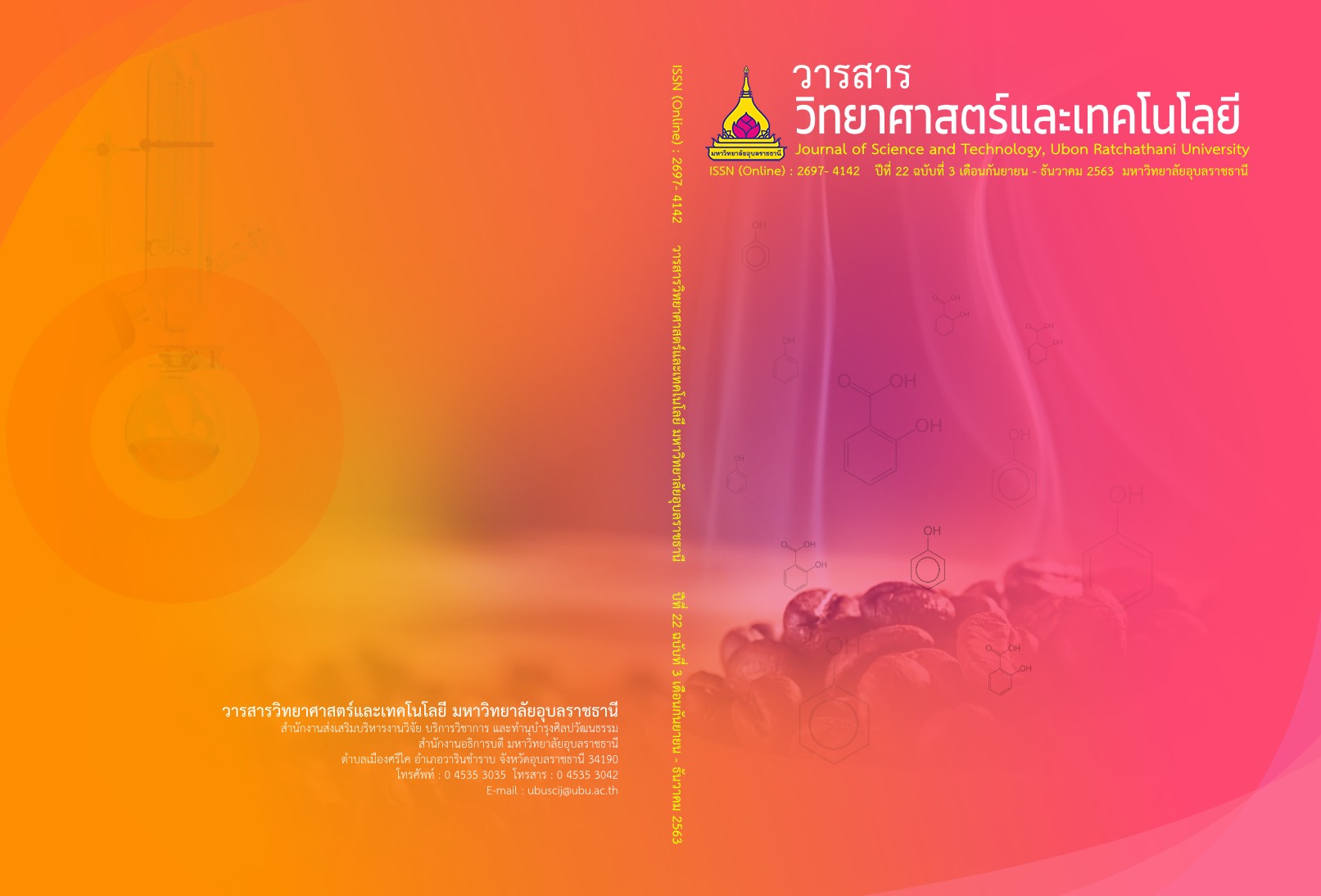กระบวนการดีคลอริเนชันไพโรไลซีสขยะพีวีซีด้วยตัวดูดซับถ่านกัมมันต์ชุบเคลือบอนุภาคนาโนเหล็กประจุศูนย์และอนุภาคเหล็ก (III) ออกไซด์
Main Article Content
บทคัดย่อ
งานวิจัยนี้ มุ่งศึกษาการปรับปรุงตัวดูดซับถ่านกัมมันต์ด้วยอนุภาคเหล็กประจุศูนย์ เพื่อใช้ในกระบวนการดีคลอริเนชันพลาสติกพีวีซี ที่ได้จากการสลายตัวทางความร้อนภายใต้สภาวะไร้อากาศหรือไพโรไลซีส ที่อุณหภูมิ 400 องศาเซลเซียส ความดันบรรยากาศก๊าซไนโตรเจน โดยถ่านกัมมันต์ชนิดเม็ด (เกรดอุตสาหกรรม) นำมาชุบเคลือบอนุภาคเหล็กประจุศูนย์ร้อยละ 2.5 (Fe-2.5/GAC) และ 5.0 (Fe-5.0/GAC) โดยน้ำหนัก และถ่านกัมมันต์ชุบเคลือบเหล็กออกไซด์ (Fe2O3/GAC) ร้อยละ 5.0 โดยน้ำหนัก การดำเนินการทดลองกระบวนการไพโรไลซีสพลาสติกพีวีซีอุณหภูมิ 400 องศาเซลเซียส ระยะเวลา 60 นาที เป็นผลทำให้พลาสติกพีวีซีเกิดการสลายตัวทางความร้อนและมีน้ำหนักลดลงถึงร้อยละ 70 โดยน้ำหนัก ก๊าซผลิตภัณฑ์ที่ได้จากการสลายตัวทางความร้อนพลาสติกพีวีซี เรียกว่าสารประกอบคลอริเนเตท ผ่านกระบวนการดูดซับด้วยตัวดูดซับของแข็งชนิดต่างๆ ผลการทดลอง พบว่า ตัวดูดซับถ่านกัมมันต์มีอัตราการดูดซับคิดเป็น 0.737×10-3 mg Cl/(g.min) การปรับปรุงตัวดูดซับถ่านกัมมันต์ด้วยการชุบเคลือบอนุภาคนาโนเหล็กประจุศูนย์ 5 wt.% สามารถเพิ่มอัตราการดูดซับก๊าซผลิตภัณฑ์คลอริเนเตทเป็น 1.73 × 10-3 mg Cl/(g.min) และให้ค่าความสามารถในการดูดซับสูงสุด 0.208 mg/g หรือมีประสิทธิภาพเท่ากับ 70% นอกจากนี้ ผลของการศึกษาไอโซเทอมของการดูดซับของตัวดูดซับชนิด GAC, Fe-2.5/GAC และ Fe-5.0/GAC สามารถอธิบายได้ทั้งแบบจำลองการดูดซับของฟรุนด์ลิช
Article Details
บทความที่ได้รับการตีพิมพ์เป็นลิขสิทธิ์ของ วารสารวิทยาศาสตร์และเทคโนโลยี มหาวิทยาลัยอุบลราชธานี
ข้อความที่ปรากฏในบทความแต่ละเรื่องในวารสารวิชาการเล่มนี้เป็นความคิดเห็นส่วนตัวของผู้เขียนแต่ละท่านไม่เกี่ยวข้องกับมหาวิทยาลัยอุบลราชธานี และคณาจารย์ท่านอื่นๆในมหาวิทยาลัยฯ แต่อย่างใด ความรับผิดชอบองค์ประกอบทั้งหมดของบทความแต่ละเรื่องเป็นของผู้เขียนแต่ละท่าน หากมีความผิดพลาดใดๆ ผู้เขียนแต่ละท่านจะรับผิดชอบบทความของตนเองแต่ผู้เดียว
เอกสารอ้างอิง
[2] Boonruam, P., Wattanachai, P. and Upasen, S. 2018. Study on Chlorinated Gas Adsorption Using Activated Carbon via Polyvinyl Chloride (PVC) Stepwise Pyrolysis Process. Proceedings. 2(20): 1-4.
[3] Luekittisup, P., Tanboonchauy, V., Chumee, J., Predapitakkun, S., Kiatkomol, R. W. and Grisdanurak, N. 2015. Removal of Chlorinated Chemicals in H2 Feedstock Using Modified Activated Carbon. Journal of Chemistry. 2015: 1-9.
[4] Enniya, I., Rghioui, L. and Jourani, A. 2018. Adsorption of hexavalent chromium in aqueous solution on activated carbon prepared from apple peels. Sustainable Chemistry and Pharmacy. 7: 9-16.
[5] Cheng, S., Zhang, L., Ma, A., Xia, H., Peng, J., Li, C. and Shu, J. 2018. Comparison of Activated Carbon and Iron/Cerium Modified Activated Carbon to Remove Methylene Blue from Wastewater. Journal of Environmental Sciences. 65: 92-102.
[6] Solgi, M., Najib, T., Ahmadnejad, S. and Nasernejad, B. 2017. Synthesis and Characterization of Novel Activated Carbon from Medlar Seed for Chromium Removal: Experimental Analysis and Modeling with Artificial Neural Network and Support Vector Regression. Resource-Efficient Technologies. 3(3): 236-248.
[7] Kumar, P.S., Prot, T., Korving, L., Keesman, K.J., Dugulan, I., Loosdrecht, M.C.M. and Witkamp G.J. 2017. Effect of Pore Size Distribution on Iron Oxide Coated Granular Activated Carbons for Phosphate Adsorption – Importance of mesopores. Chemical Engineering Journal. 326: 231-239.
[8] Lemus, J., Martin-Martinez, M., Palomar, J., Gomez-Sainero, L., Gilarranz, M. A. and Rodriguez, J. J. 2012. Removal of Chlorinated Organic Volatile Compounds by Gas Phase Adsorption with Activated Carbon. Chemical Engineering Journal. 211-212: 246-254.
[9] Messele, S.A., Soares, O.S.G.P., Órfão, J.J.M., Bengoa, C., Stüber, F., Fortuny, A., Fabregat, A. and Font, J. 2015. Effect of Activated Carbon Surface Chemistry on The Activity of ZVI/AC Catalysts for Fenton-like Oxidation of Phenol. Catalysis Today. 240: 73-79.
[10] Huang, D., Wang, G., Shi, Z., Li, Z., Kang, F. and Liu, F. 2017. Removal of Hexavalent Chromium in Natural Groundwater using Activated Carbon and Cast Iron Combined System. Journal of Cleaner Production. 165: 667-676.
[11] Boonruam, P., Soisuwan, S., Wattanachai, P., Morillas, H. and Upasen, S. 2020. Solvent Effect on Zero-Valent Iron Nanoparticles (nZVI) Preparation and Its Thermal Oxidation Characteristic. ASEAN Engineering Journal. 10(2): 1-12.
[12] Upasen, S. 2018. Activated Carbon-Doped with Iron Oxide Nanoparticles (a-Fe2O3 NPs) Preparation: Particle Size, Shape, and Impurity. International Journal of ChemTech Research. 11(10): 33-40.
[13] Ahmed, O.H., Altarawneh, M., Jiang, Z.T., Al-Harahsheh, M. and Dlugogorski, B.Z. 2017. Reactions of Products from Thermal Degradation of PVC with Nanoclusters of Alpha-Fe2O3 (hematite). Chemical Engineering Journal. 323: 396-405.
[14] Bi, W. Z., Chen, T. J., Zhao, R. D., Wang, Z. Q., Wu, J. L. and Wu, J. H. 2015. Characteristics of a CaSO4 Oxygen Carrier for Chemical-Looping Combustion: Reaction with Polyvinylchloride Pyrolysis Gases in a Two-Stage Reactor. RCS Advances. 5(44): 34913-34920.


